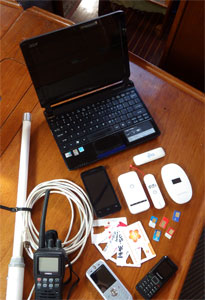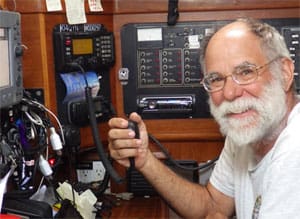Times have changed from sending a message in a bottle and hoping someone finds it. Now, aboard the cruising sailboat Astarte, a Moody 422, we have lots of ways to communicate — and we’re a relatively “low-tech” boat when it comes to this. We’ve also noticed over the six years of cruising that we are spending more of our cruising budget on the “communication” category and are more dependent on the Internet and our computers.
Offshore
This is when we are out of range of cell towers and Internet cafes. We have tackled many long passages and are satisfied with our communication systems: an Icom M802 HF/SSB/ham radio. We also have an SCS Pactor modem that we bought in 1999 from a cruiser that was swallowing the anchor. This has been upgraded to Pactor III. The Pactor allows us to use the HF radio to send and receive emails and more importantly, to get lots of weather info.
We subscribe to “Sailmail” for $250 (US) per year and Michael has an amateur radio license, so we also use Winlink (the free service for ham operators). The SSB radio provides access to various radio nets — both formal and “ad hoc,” created by groups of friends or people traveling on the same route. This is one of our favorite reasons to have an HF radio. In fact, our friend Heather, aboard Evergreen once said that without the radio she would feel “socially isolated.” The nets provide a “safety net,” condition reports, weather forecasts and warnings, as well as daily entertainment. We have met many cruising friends as a result of the radio — it gives you an instant introduction when you see a boat you heard on the airwaves. We get daily GRIB files through the HF radio/Pactor. And, it keeps us in touch via email with family and friends in case of news from back home and emergencies.
We do not have a sat-phone as we feel like the radio, in an emergency, would suffice thanks to many maritime networks that operate around the clock. In fact, while at anchor near a remote atoll in the Marshall Islands where there was no phone or wireless service, we had a medical issue and the SSB allowed us to e-mail our doctor in the U.S. for help.
 |
|
An array of the gadgets that help us communicate aboard our boat Astarte. From top computer clockwise: Acer laptop for emails; new cellphone; various dongles and pucks from various countries for wireless; SIM “chips” and prepaid cards; collection of unlocked cellphones; hand-held VHF radio; wireless “booster” antenna for wireless. |
|
Michael Hawkins |
Near shore
The VHF radio is a necessary tool to contact appropriate officials when entering a new port or country as well as for contacting bridges and approaching vessels. It is also important to have for offshore use. If our AIS (we have a receiver but will soon be getting a transmitter as well), tells us a vessel is nearby and approaching closely, we contact them to let them know we are in the vicinity. This is especially true in bad weather when visibility isn’t that great. The AIS gives you the name of a vessel so you can more easily contact them.
At anchorage
We have a cell phone that is unlocked and takes a SIM card. In fact, just recently we’ve finally had to update our phone to one that allowed 3G coverage! If we are going to be in a country for a while, we will buy a local SIM card from one of the services (after shopping around) and prepaid cards for the calls/time. For Internet, we use Internet cafes, look for free wireless hot spots or buy a local service. We have an external Wi-Fi antenna with amplifier that allows us to boost our Wi-Fi range aboard. In many places, we have been able to get a decent signal from a tower while at anchor. This makes using the Internet more convenient. For the service, we shop around and ask other cruising boats what the best deal is in town/country. We have quite a collection on board of various “dongles” and “pucks” and SIM cards for data from the various countries we’ve visited. We have learned that in most countries, if you have the option to buy wireless by “time” or “data,” buy the data! Many countries have very, very, very slow Internet and it may take 15 minutes to download one banking page.
We also have a hand-held VHF radio so if one of us goes off in the dinghy or to shore, they can still be in communication with the other aboard Astarte. This is a great safety tool — and it’s free!
We try not to spend too much time with computers belowdecks. The reasons we are out here voyaging is to see these remarkable countries and meet interesting folks. Being “unhooked” is one of the pleasures of the cruising life — but there is also the necessity of weather, safety and social communications. It is a balancing act.
Oh, and we still send a message by “bottle mail” whenever we cross the equator!
Barbara Sobocinski and Michael Hawkins live aboard their Moody 422, Astarte, and are currently in New Zealand.

